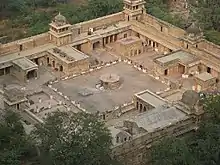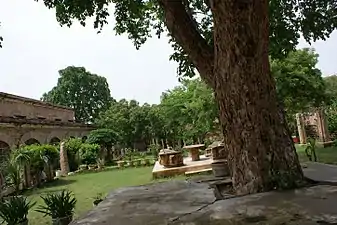Gujari Mahal Archaeological Museum
The Gujari Mahal Archeological Museum or State Archaeological Museum, sometimes called the "Gwalior Fort Museum", is a state museum in Gwalior, located in the fortress of Gujari Mahal.[1] It displays the love between a Rajput ruler and his Low caste Gujjar wife which is a symbol of rebel in chambal where a Ruler goes against the community norms and marry a low caste wife and build a separate palace for her.[2]


The palace of Gujari Mahal was built by Tomar Rajput ruler Man Singh Tomar for his wife Mrignayani who belonged to Gujjar tribe. Due to the friction between Mrignayani and his other wives as Mrignayani was of lower caste, Raja Man Singh built the separate palace for her below the Gwalior fortress. The palace has been converted into an archaeological museum. Rare artifacts at the museum include Hindu and Jain sculptures dated to the 1st and 2nd centuries BCE, miniature statue of Salabhanjika, terracotta items and replicas of frescoes seen in the Bagh Caves.
| Artifacts at the Gujari Mahal Archaeological Museum |
|
References
- Official website for tourism in the Madhya-Pradesh region
- Buddhist Landscapes in Central India: Sanchi Hill and Archaeologies of Religious and Social Change, C. Third Century BC to Fifth Century AD, Julia Shaw, Left Coast Press, 2013, p.89

%252C_Gwalior_Fort%252C_Gwalior.jpg.webp)

